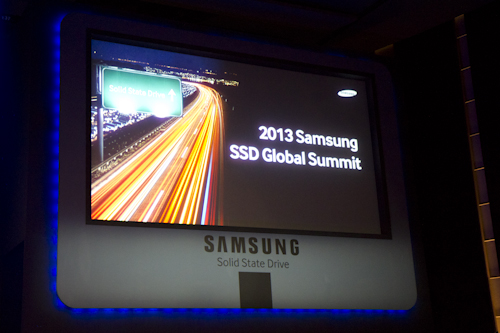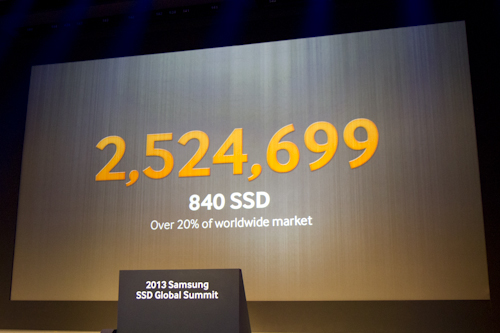Samsung's SSD Global Summit: The Leader In NAND Speaks Up
The theme of this year's Samsung SSD Global Summit, in Seoul, Korea, was SSDs For Everyone. More than 100 journalists from around the world showed up for this one-of-a-kind event, where we got a taste of the future in solid-state storage.
An Editorial On Write Endurance
When Samsung launched its 840 last year, the technical press expressed concern about the write endurance of triple-level cell memory. A number of folks seemed to think that a 1000 program/erase-cycle rating meant that the 840s would start failing after a few months. Of course, we've seen that those fears were largely exaggerated. The general sentiment toward TLC NAND remains, though. Many readers who know what triple-level cell memory is, but haven't spent any time testing it, tend to distrust the technology.
If you don't think your comments are being read at a company as large as Samsung, you are mistaken.
At last year's SSD Global Summit, Samsung was very coy about its triple-level cell NAND. It didn't even want to talk about lithography. During one Q&A session with company executives, the same questions were asked multiple times before Samsung gave up some answers. Write endurance inquires were deftly deflected, too. Everyone in the room already knew that Samsung's TLC NAND was rated for ~1000 program/erase cycles, but the execs refused to confirm. They tried claiming the company's TLC-based products were on par with SSDs built using two-bit-per-cell flash on the same node. Confidence was not inspired by those responses.
This year, however, Samsung went on the offensive with TLC NAND. Even our own storage team had already taken 840s over 3000 P/E cycles before sectors started getting reallocated. So, Samsung showed us the math on how much data has to go through an 840 before it's at risk of failure. By the end, it appeared that everyone in the room believed an 840 (or 840 EVO now) offers enough write endurance headroom for most desktop applications.
As Tom's Hardware's enterprise storage editor, I discuss endurance in each of my stories. Business workloads can be downright hostile to solid-state storage. I'm talking random writes, 24 hours a day. In many applications, even eMLC NAND rated for 35,000 P/E cycles is inadequate. I've personally exhausted more MLC-based drives than I care to even think about. But I'm also a client user. I write stories, render video, edit pictures, and compile code. I've been using SSDs for years without ever measuring I/O on my personal workstation.
What did I find when I pulled up that data? Apparently, I don't write very much to my drive. On an SSD that was in my system for two years, I had written a total of 2 TB. At that rate, Samsung's 120 GB 840 would last me more than 120 years, while the 250 GB model would have the write endurance to go 250 years. Even with write amplification factored in, you're looking at plenty of time beyond the three year warranty.
Perhaps what Samsung knew all along was that write endurance doesn't tell the whole story of reliability. Yes, the company's triple-level cell flash has about one-third of today's MLC NAND. But does that really matter? With sales greater than 2.5 million units in 10 months, a lot of customers either don't think so or don't know any different.
Get Tom's Hardware's best news and in-depth reviews, straight to your inbox.
Current page: An Editorial On Write Endurance
Prev Page Advancements Beyond NAND, Continued Next Page SSDs For Everyone-
ojas Well, i have 2.3 TB of writes and 4.36 TB of reads on my 120GB Intel 320 series SSD in the last year...no re-allocated sectors thus far.Reply
My 840 has about 0.41TB written to it, and i bought this drive a few months ago.
Anyway, looking forward to RAPID. -
Someone Somewhere @radiovan I read it as being that it's a replacement for AHCI/IDE - it'll still work with SATA.Reply
Anyone else find that this reads like an infomercial? -
Steveymoo Ahh Samsung, you're still not immune to the age old marketting technique of combining large breasted women with your technology, to catch men's eyes.Reply -
Onus Organizations with huge amounts of data to sift (e.g. Google, NSA, IRS) will want any speed they can get. Labs doing FCAT testing need ridiculous write speeds. For the rest of us, as individuals, if a bloated application like Word already loads in the blink of an eye, any faster simply doesn't matter. I hope a substantial focus can be placed on cost.Reply -
JPNpower CPUs GPUs are sort of slowing. this is the future. This is innovation at its hottest and fastest. Maybe it is competition as some say, as AMD is bogged down in processors, giving the leaders a healthy lead, but in flash, Samsung, Sandisk/Toshiba, and Micron are hot at it.Reply
Everyone wins. -
jabliese radiovan and SomeoneReply
NVMe is a protocol to work with PCIe. This is quite clear from the slides. What is PCIe? Do you remember your last video card upgrade? The slot your card plugged into was most likely a PCIe slot. NVMe has no business with SATA, and that's the way you want it to be. -
drewriley Reply11318974 said:No word on when we might be seeing the new vertical NAND in products?
Last year, Samsung touched on some new technologies that they were working on, but didn't share any insight during their latest summit,

